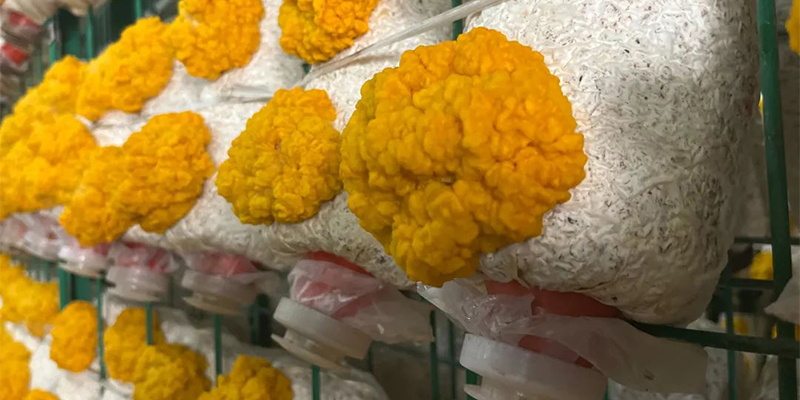7 Cultivation Points of Golden Ear

Golden ear is a kind of precious wild edible fungus, which is rich in fungal polysaccharides, plant protein and trace elements such as phosphorus, sulfur, manganese, iron, magnesium, calcium and potassium. It is a nutritional tonic and can be used as medicine.
The number of wild golden ears is very rare, so golden ears have always been enjoyed by the royal family as a top tribute in history. Today, golden ear has been cultivated artificially in many places, and today I will share the relevant cultivation techniques as follows.
1. Place selection
At present, the mushroom-growing places are mainly ordinary greenhouses (vegetable planting greenhouses) and intelligent mushroom-producing greenhouses (mushroom-producing rooms). Ordinary greenhouses can only be planted in accordance with the seasons, and can be planted in a single layer or multi-layered; intelligent mushrooming greenhouses (equipped with air-conditioning) can be planted in multiple layers in four seasons.
2. Environmental treatment
No matter what kind of facilities are planted in greenhouses, it is necessary to do a good job in environmental sanitation cleaning and insect control and sterilization in advance. On the basis of cleaning, use glutaraldehyde, 84, carbendazim, beta-cypermethrin and other drugs to kill.
3. Quality screening of bacterial packs
The quality of the fungus bag determines the quality of the fruiting, so we must be cautious in the selection. We must choose a regular factory, the fungus bag has normal growth, the mycelium is strong, there are small mushroom buds, and there is no sign of infection. During transportation, it should not be subjected to high temperature (≤25°C) or too long time (≤10 hours is better). Long-term stack pressure, prone to high temperature and oxygen deficiency.
4. Planting in sheds
1)Place the bacteria bag. Place the bacteria packs evenly on the fruiting rack of the planting shed, with the spores facing up.
2)Temperature. The temperature is controlled at 15-28 degrees. If the temperature is high, turn on the air conditioner to cool down or use water spray ventilation to cool down.
3)The relative humidity of the air. Before flaring, the normal humidity of the air is sufficient, and there is no need to spray water to humidify the space.
4)Light. Before flaring, no light is needed.
5)Air. Ventilate 2 to 4 times a day under suitable temperature conditions, about half an hour each time.
6)Bacteria completion standard. Most of the golden ear mushroom buds are as big as peanuts, so they can be expanded and fruited, and enter the fruiting management.
5. Mushroom management
1)Flaring. Use a knife to cut the plastic film along the surrounding of the mushroom buds, and make a small opening as much as possible. The scratched plastic film does not need to be removed for the time being, and it will be removed after the mushroom buds push it apart by themselves.
2)Temperature. Summer fruiting temperature is controlled between 16-28 ℃.
3)Relative humidity. After entering the ear management, the humidity gradually increases. When flaring, it is controlled at 75%-85%. The overall humidity is suitable for the space. The humidity in the later stage is controlled at about 90%. The humidification is mainly based on high-pressure micro-spray humidification. If the water on the fruit body is too large after spraying, ventilation should be combined to allow the water droplets on the fruit body to evaporate.
4)Ventilation and air permeability. Keep the air fresh. Ventilate 3 to 5 times a day under suitable temperature conditions, and try to control the carbon dioxide below 1800. The lower the carbon dioxide content, the better, indicating that the oxygen content is relatively high, which is conducive to the growth of fresh mushrooms.
5)Light. When golden ear mushrooms are fruiting, they are white in the early stage, and the temperature, humidity, light and other conditions are used to stimulate it to change from white to yellow. The light should be scattered light, 500-2000LX, avoid direct sunlight and excessive shade. For indoor cultivation, if you use LED light tubes or light strips for supplementary light, you need a model with higher power. When cultivating in a greenhouse, a sunshade net should be covered, such as a six-pin encrypted sunshade net layered on the shed.
Generally, the light is turned on when the young mushrooms grow to the size of egg yolks, and can be illuminated for about 5 hours a day in the early stage. Later, as the fresh mushrooms grow up, the light time is gradually increased, combined with the comprehensive effects of temperature difference stimulation, light, humidity, etc., and finally the color of the fresh mushrooms gradually turns yellow, reaching the standard of commercial mushrooms.
6. Picking and storage
As long as the color turns to look good, it can be picked and sold after it is determined that it has reached a suitable color from the visual point of view. If it is not sold in time, when you see powdery white powder on the fresh mushrooms, there should be spore powder, indicating that they have matured and need to be picked and sold in time.
7. Drying of fresh products
For fresh products that cannot be sold in time, the roots should be cut and dried in time. When drying, the mode of first low temperature and then high temperature should be adopted. Ventilate and dehumidify first, and then heat and dry. The maximum temperature should generally not exceed 55 degrees. It usually takes about 30 hours to dry with quality.

(1)(1).jpg)
 CONTACT
CONTACT